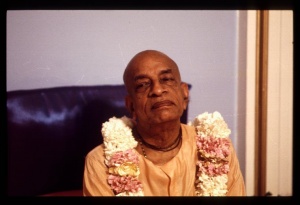SB 1.16.18

A.C. Bhaktivedanta Swami Prabhupada
TEXT 18
- dharmaḥ padaikena caran
- vicchāyām upalabhya gām
- pṛcchati smāśru-vadanāṁ
- vivatsām iva mātaram
SYNONYMS
dharmaḥ — the personality of religious principles; padā — leg; ekena — on one only; caran — wandering; vicchāyām — overtaken by the shadow of grief; upalabhya — having met; gām — the cow; pṛcchati — asking; sma — with; aśru-vadanām — with tears on the face; vivatsām — one who has lost her offspring; iva — like; mātaram — the mother.
TRANSLATION
The personality of religious principles, Dharma, was wandering about in the form of a bull. And he met the personality of earth in the form of a cow who appeared to grieve like a mother who had lost her child. She had tears in her eyes, and the beauty of her body was lost. Thus Dharma questioned the earth as follows.
PURPORT
The bull is the emblem of the moral principle, and the cow is the representative of the earth. When the bull and the cow are in a joyful mood, it is to be understood that the people of the world are also in a joyful mood. The reason is that the bull helps production of grains in the agricultural field, and the cow delivers milk, the miracle of aggregate food values. The human society, therefore, maintains these two important animals very carefully so that they can wander everywhere in cheerfulness. But at the present moment in this age of Kali both the bull and the cow are now being slaughtered and eaten up as foodstuff by a class of men who do not know the brahminical culture. The bull and the cow can be protected for the good of all human society simply by the spreading of brahminical culture as the topmost perfection of all cultural affairs. By advancement of such culture, the morale of society is properly maintained, and so peace and prosperity are also attained without extraneous effort. When brahminical culture deteriorates, the cow and bull are mistreated, and the resultant actions are prominent by the following symptoms.